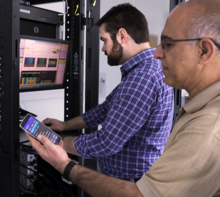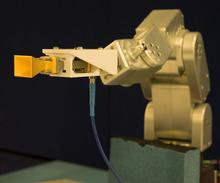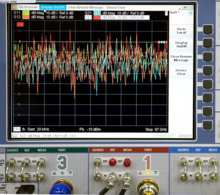Summary
The availability of wireless spectrum bandwidth has a profound impact on US industry’s ability to engineer a new generation of wireless devices. This program provides robust test processes and validated measurement data that is necessary to develop, evaluate, and deploy spectrum sharing technologies. The NIST CTL trusted spectrum testing program addresses three core challenges facing our wireless future: coexistence metrics, spectrum management, and waveform metrology and calibration.
Description

COEXISTENCE METRICS
The Trusted Spectrum Testing program focuses on coexistence metrics and testing methods for wireless systems in shared-spectrum environments. With the goal of understanding a system's response and impact on a local radio frequency environment, our RF Technology Division measures complex in-building wireless emissions, maps penetration of outdoor signals into those spaces, and analyzes leakage from nearby equipment. Long term, our efforts support US industry as they develop equipment that will exceed current capabilities in terms of operating in crowded wireless conditions. Nearer term, we help protect Federal and Defense users while supporting increased spectrum sharing by both federal agencies and non-federal spectrum users. CTL's National Advanced Spectrum and Communications Network (NASCTN) program brings together member organizations NIST, NTIA, DOD, NASA, NSF, and NOAA which provide unique capabilities to tackle difficult measurement problems in shared spectrum. Through NASCTN, they exchange spectrum-sharing research and technology, make engineering resources and test facilities available, and contribute restricted data that drives research results. NASCTN works with its members to create independent scientifically rigorous test plans and new methodologies, access key test facilities, and validate results. NASCTN fully protects proprietary or sensitive information used in or generated by its spectrum testing projects.

SPECTRUM MANAGEMENT
As an impartial and trusted source, we develop test methods to evaluate how effective centralized spectrum-management approaches are at protecting incumbent (primary) users. This work extends to assessing the performance of secondary wireless systems as well as comparing the spectrum-utilization efficiency of alternative solutions. The RF Technology Division's work directly supports Federal and Military spectrum users, whose allocated spectrum is the focus of tiered access spectrum sharing efforts in the US. This system will be critical to protecting the integrity of existing systems in the face of new spectrum users. Chief among these are upcoming devices that will use recently allocated bandwidth in the 3.5GHz range (Citizens Broadband Radio Service), expected to include a variety of hardware and applications such as Industrial IOT sensors and private LTE networks. Our RF Technology, NASCTN, and Wireless Networks Divisions are developing tests and reference implementations to support Spectrum Access Systems (SAS) that mediate RF usage between secondary and U.S. ground-based and shipborne radar systems.

WAVEFORM METROLOGY & CALIBRATION
NIST CTL's Shared Spectrum Metrology Group is developing traceable and rigorous test methods for over-the-air testing of wireless systems. The ultimate goal of these and many of our other endeavors is to quantify RF environments, spectrum usage and wireless system behavior so that policymakers and industry leaders can make informed decisions based on NIST CTL's independent analysis. Regulators require accurate digital waveforms that can be used to test and certify commercial RF sensors. This Environmental Sensing Capability (ESC) is a focus of NIST CTL’s Wireless Networks Division, which is researching the use of 3.5GHz sensors to dynamically detect and protect against potential interference to Federal radar systems. The Wireless Networks Division also leverages artificial intelligence and data mining to classify and characterize 3.5GHz waveforms.

